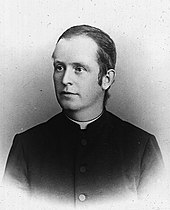Hermann Schmitz (entomologist)
Hermann Johann Schmitz S. J. (born August 12, 1878 in Elberfeld ; † September 1, 1960 in Bad Godesberg ) was a German entomologist , priest and teacher . His research focus was the humpback flies (Phoridae), for which he described several species and genera anew . At the age of fifteen he began training with the Jesuits , where he received scientific and theological training. As a professor he taught at the Jesuit college in Valkenburg until it was closed by the Gestapo in 1942 and Schmitz was arrested. After the end of the Second World War he taught at the Aloisiuskolleg in Bad Godesberg, where he died in 1960.
biography
Origin and youth (1878–1899)
Schmitz was born in 1878 in Elberfeld, Berg, as the eldest of seven children of Gertrud Schmitz (née Breuer) and her husband August, a teacher. Schmitz first attended school in Elberfeld and later in nearby Rheinbach . When he was twelve years old, his father died. In 1894 Schmitz became a novice in the Dutch Jesuit College Afferden , where he continued his schooling. Two years later he moved to Exaten in the province of Limburg , where he mainly deepened his Latin studies. In Exaten he got to know the Jesuit and biologist Erich Wasmann . Wasmann took the young Schmitz on his entomological excursions for three years , on which Schmitz served as his assistant, and introduced him to entomology .

Teacher, beginnings in science and doctorate (1899–1929)
At the beginning of 1899 Schmitz switched to the Jesuit college in Valkenburg , where he studied philosophy until the end of 1901. After completing his studies in Oudenbusch , he worked in 1902 at the Aloisiuskolleg in Sittard as a teacher of mathematics and natural sciences. In the same year, Janós Thalhammer gave the Aloisiuskolleg his collection of two-winged species comprising 3,000 specimens and commissioned Schmitz to collect mosquitoes and flies around Sittard, which marked the point of entry into dipterology. At the same time, Schmitz continued to work with ants. During this time he wrote his book The Ants and Their Guests . In 1906 he became Wasmann's assistant in Luxembourg for a year before studying theology in Maastricht for two years from 1907 and then being ordained . In 1911 and 1912 he studied natural sciences in Loewen and then returned to Sittard as a teacher. In the same year he also took over the chairmanship of the Natural History Genootschap Limburg. In 1915 his ant study De Nederlandsche mieren en Haar gasten appeared in the Genootschap yearbook and received a great deal of attention from specialist circles. Schmitz went to Bonn in 1921 , where he studied biology until 1922. In 1923 he assisted Erich Wasmann in Valkenburg for another two years. Then he went to the University of Freiburg , which awarded him a doctorate in 1926. His dissertation , a taxonomic revision of the humpback flies (Phoridae), appeared in 1929 and was supervised by August Reichensperger .
Research trips, Third Reich and post-war period (1930–1960)
Following his doctorate, Schmitz received a professorship at the Valkenburger Ignatiuskolleg. 1937 and 1939 he went to the Irish Tullaberg to explore the local flora and humpbacked flies at the Jesuit high school to teach. Schmitz stayed in Ireland for four years and then returned to the German- occupied Netherlands to teach as a professor at the Jesuit college in Valkenburg . In 1942 the Gestapo dissolved the college and imprisoned the teaching staff. Schmitz's entomological collection was confiscated and taken to Waischenfeld , where it was to become part of the Imperial German " Ahnenerbes ". Schmitz was released from prison in the same year and went to occupied Austria, where he researched the phorid flora of the Alps. After the fall of the National Socialists, he returned to Germany in 1946 and from then on taught at the Aloisius College in Bad Godesberg . He got his collection back and continued his research until he died of a heart attack on September 1, 1960 in Bad Godesberg .
plant
Schmitz made a special contribution to the research and systematic development of humpback flies. His three monographs on the systematics of the Phoridae remained the authoritative works in the field for over 60 years. In the course of his life , Schmitz described around 80 genera and 650 species and put together an extensive collection of around 40,000 specimens, which is now housed in the Alexander König Museum. His main journalistic work consists, in addition to his initial descriptions and revisions, above all of the 500-page part “Phoridae” in Erwin Lindner's Die Flies der Palaearctic Region .
swell
literature
- JKA van Boven: In Memoriam Pater Hermann Schmitz SJ 1878-1960. In: Natuurhistorisch Maandblad 50, 1960. pp. 112–117.
- Sabine Prescher: Hermann Schmitz. In: Biographisch-Bibliographisches Kirchenlexikon (BBKL). Volume 30, Bautz, Nordhausen 2009, ISBN 978-3-88309-478-6 , Sp. 1290-1291.
- Sabine Prescher, Gisela Weber: In Memoriam Pater Hermann Schmitz SJ. In: Studia dipterologica 8 (1), 2000. pp. 277-288.
Web links
- Jesuitica: The Flies of Ireland. In: Irish Jesuit News , www.amdg.ie, August 31, 2010.
Individual evidence
- ↑ a b Boven 1960, p. 113.
- ↑ a b Prescher & Weber 2000, p. 278.
- ↑ Irish Jesuit News 2012. Retrieved July 27, 2012.
- ↑ a b Prescher 2009. Retrieved July 27, 2012.
| personal data | |
|---|---|
| SURNAME | Schmitz, Hermann |
| ALTERNATIVE NAMES | Schmitz, Hermann Johann (full name) |
| BRIEF DESCRIPTION | German entomologist and Jesuit |
| DATE OF BIRTH | August 12, 1878 |
| PLACE OF BIRTH | Elberfeld |
| DATE OF DEATH | September 1, 1960 |
| Place of death | bad Godesberg |